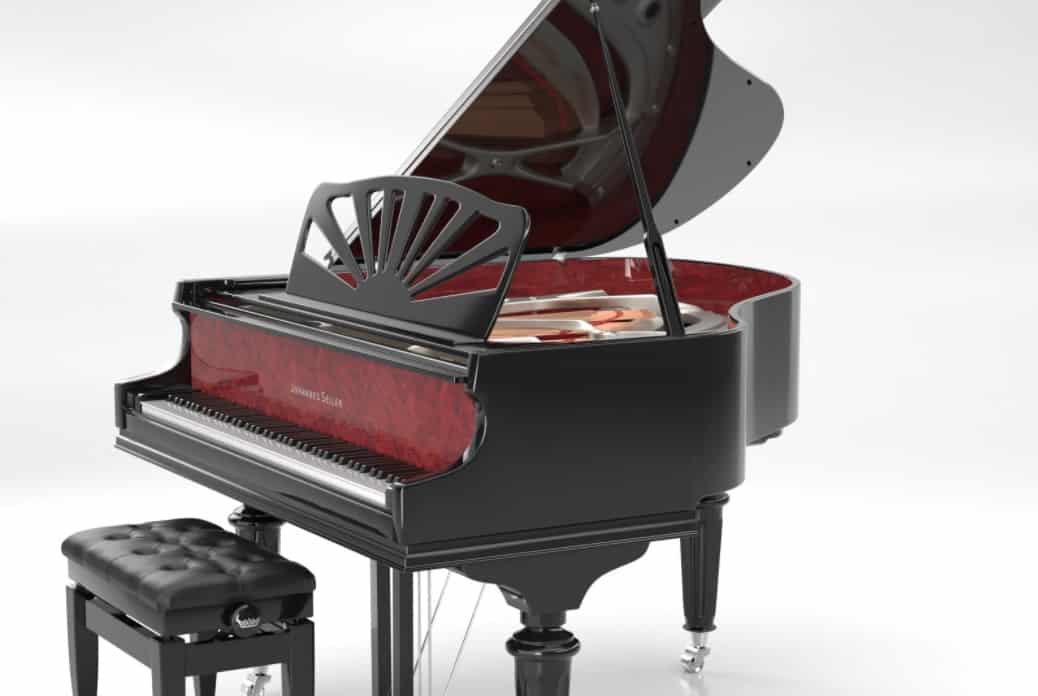
Of all the different brands of pianos available in today’s crowded marketplace, I have to say that Seiler has one of the most engaging websites of them all. Partly it is the look and feel of the site, but it has videos of the manufacturing of the pianos on the homepage that I find appealing. It seems to demonstrate a burning passion for their art and their instruments.
Seiler Piano Review
The Seiler piano brand has been around for over 160 successful years and it is still in business today. It was a man called Eduard Seiler who began this line of pianos in a charming town called Liegnitz in Germany. Eduard’s vision was simple; to make first-class pianos that matched the aspirations and demands of the greatest musicians of the time, and to bring quality pianos to the increasingly wealthy middle-classes.
Eduard Seiler enjoyed relatively swift success with his new line of pianos. In 1872, he received a gold medal in Moscow for the ‘outstanding quality’ of his pianos. This paved the way for Seiler’s rise to piano manufacturing fame and despite the terrible wars that raged between 1884 and 1871, the company continued to grow. A new steam-powered factory was established in 1873 with soon over one hundred workers employed.
Sadly, Eduard Seiler died in 1875 and the company passed to his two sons Max and Paul. Tragedy struck the Seiler family when both Max and Paul Seiler died in 1879. The youngest son Johannes, who had only just completed his piano manufacturing apprenticeship was left to direct the Seiler company.
With the addition of August Lauterberg (brother-in-law to Johannes), and Oswald Kasing the Seiler company achieved considerable accreditation, cornering the German piano market by the last 1800s. Prizes and more awards were heaped on the Seiler company with a huge expansion of manufacturing facilities taking place in 1896 and 1907. By 1923 and now under the capable leadership of Anton Seiler-Dütz, the company is the largest manufacturer of pianos in Eastern Germany.
The Second World War heralds a significant change for the Seiler brand. Their headquarters and factories are largely lost in Liegnitz and they must risk everything to begin again. Thankfully, the designs and over one hundred years of experience were not lost and the Seiler company again began to re-establish themselves as manufacturers of quality instruments. The ethos and values that were fostered by Eduard Seiler were upheld as the company began producing pianos initially in Denmark, then later in Bavaria in the early 1960s. Not only was it imperative that the name of Seiler continued to represent the best in piano design and manufacture but that the characteristic sound of the instruments was true to the original aspirations of the founder.
It was Steffen Seiler (son of Anton Seiler Dütz), who kept the companies head above water. He was as much a pioneer as his predecessors, with an unswerving determination to keep the name of Seiler alive. Steffen Seiler was an innovator. He developed a unique system called the Super Magner System as well as the ground-breaking DuoVox system that in some respects paved the way for the production of electronic pianos.
More tragedy came in the years that followed with the untimely death of Steffen Seiler, and in 2008 the company became part of the Samick group. This did not spell the end for the Seiler piano company. Even though manufacturing moved mostly to Indonesia, in 2011 a new series of ‘Seiler’ pianos came to the market, made to the high specifications of the German models. This series included upright and grand pianos of which the ED168 and 186 have been extremely well received.
Following this success 2013 saw the arrival of the Eduard Seiler range whose inspiration was the founder himself and reflected his specific ideas about how a piano should look and sound. In 2018 the Seiler series incorporated the Super Magnetic Repetition Action into models ED-126 and 132. In short, this revolutionary design allows for a rapid key to hammer action by using repelling magnets.
Many discussion forums are accessible by anyone interested in pianos, where it is possible to read people’s views of Seiler pianos. Seiler pianos have continued to manufacture both the upright range alongside an impressive series of grand pianos. One recent evaluation focused on the Seiler ED-132 and the Yamaha U1.
One price alone, there is not much to tell them apart as they both hold a price of around $4000 new. The finish of these pianos is not dramatically different either although the build-quality of the Seiler appears to be more robust. Inside the instruments, the Seiler tends towards more expensive components and a distinctly German action whereas the Yamaha uses a Japanese action and more modest components. The timbral qualities of each are quite distinct. To my ears, the Yamaha is decidedly lighter throughout its compass whereas the Seiler has a fuller, richer sound that to me is more appealing.
Whether you might be thinking of acquiring a new or used Seiler piano you can be sure that the traditions of quality piano making have endured for over 170 years. Not only did Eduard Seiler realize his dreams of creating a first-class piano with cutting-edge technological innovation and a unique sound, but he also set in motion a manufacturing business that stood the test of time. The older Seiler pianos, especially the grand pianos were exceptional instruments made to meet high expectations and crafted with passion. A passing glance at the list of famous names who have ratified the Seiler brand is impressive.
Through tragedy, wars, and different directorships Seiler pianos have continued to make unique and distinct pianos that hold great appeal to thousands of pianists across the world. Their grand pianos are exported to around thirty countries globally and the business continued to thrive against the odds. If you’re interested in a new Seiler Grand Piano then the ED-208 is at the top of the pile with a price of around $68,000.
At the other end of the scale is the equally illustrious ED-168 at a cool $40,000. Uprights are available in an impressive range of styles and with prices stretching across the range of $10,000 – $45,000. Seiler believes wholeheartedly in their pianos and upholds the traditional values that began nearly two centuries ago. In today’s world of quick-fix and bulk manufacturing for a quick profit, Seiler has managed to maintain status and credibility. That has to be worth a lot.
